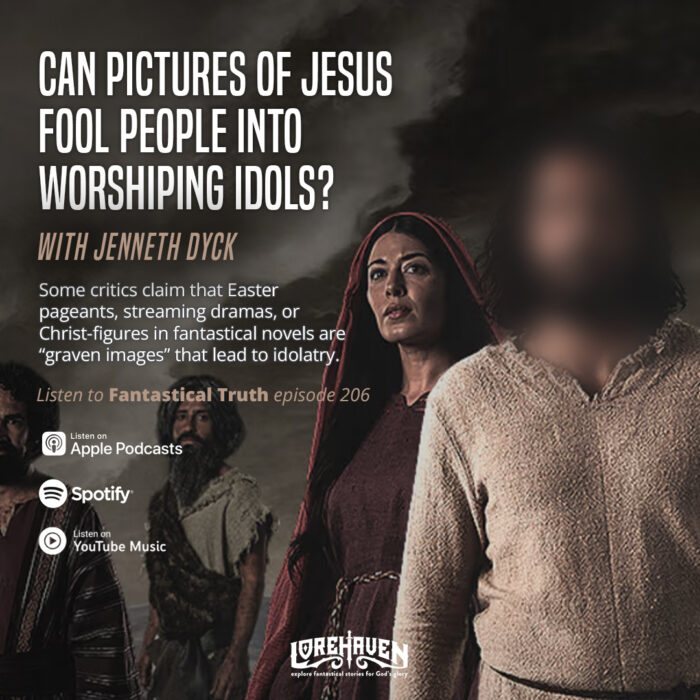206. Can Pictures of Jesus Fool People Into Worshiping Idols? | with Jenneth Dyck
Podcast: Play in new window | Download (Duration: 1:32:02 — 85.6MB) | Embed
Happy post-Resurrection Sunday! How did that go at your church? Did you see any Easter pageants? Pictures on the bulletin showing nail-scarred hands, or a shadowy figure exiting a tomb surrounded by light? And what about the Jesus-like hero in your favorite fantastical story? Could these images fool some people into sins like worshiping an imposter Jesus?
Episode sponsors
- Enclave Publishing: The Chaos Grid
- Changelings: Insurgence by Liam Corley
- Story Embers summit, May 23–25, 2024
Mission update
- We reviewed Tattoo of Crimson and it’s also our Book Quest!
- Subscribe free to get updates and join the Lorehaven Guild.
 Introducing guest Jenneth Dyck
Introducing guest Jenneth Dyck
Graphic designer Jenneth Dyck is a dyslexic writer and illustrator who creates professional book covers for indie authors and small press publishers. She also thinks way too deeply about superhero movies, quantum physics, angels, and the fourth dimension. She holds degrees in professional writing and digital media with an M.A. in graphic design.
1. What kinds of pictures of Jesus do we make?
- Going back to antiquity: earliest image was by haters in the first century.
- By the third century people were making images meant to honor Him.
- Source: Aleteia (a Catholic website), The six oldest images of Jesus, 2018
- In modern times, we see mocking images, for sure. e.g. “Buddy Christ.”
- But we see respectful treatments, like film dramatizations of the gospels.
- Stephen’s favorites include The Gospel of John (2003) and Risen (2016).
- And of course there’s the blockbuster multi-season drama The Chosen.
- In these films and shows, actors portray Jesus, so we see mainly humans.
- But at holidays like Christmas and Easter, Jesus pictures really come out.
- Christmas: we see Him mainly in His weakness, as a newborn infant.
- Easter: we see Him in weakness, a suffering servant, then as risen Man.
- We don’t have yet a holiday for Christ triumphant, returned to reign!
- A key point: each image captures Jesus at particular times in history.
- They are indeed limited, just as people saw Him “limited” at the time.
2. Why do some Christians claim these are ‘2CV’?
- “2CV” means “Second Commandment violation,” seen oft in interwebs.
- People use this, sincerely or sarcastically, to critique pictures of Jesus.
- They’ll jokingly or honestly apply a “2CV shield” over such images.
- Stephen once saw writer Tim Challies “censor” The Shack’s movie poster.
- Their key text is of course the Second Commandment in Exodus 20:4–6
“You shall not make for yourself a carved image, or any likeness of anything that is in heaven above, or that is in the earth beneath, or that is in the water under the earth. You shall not bow down to them or serve them, for I the LORD your God am a jealous God, visiting the iniquity of the fathers on the children to the third and the fourth generation of those who hate me, but showing steadfast love to thousands of those who love me and keep my commandments.”
- This seems an open-and-shut case. But the argument proves too much.
- Do we truly believe we can’t make “any likeness of anything” in creation?
- God groups these commandments together; we can’t separate them.
- The clear context is the phrase “bow down to them or serve them.”
- No one should worship any graven image, of God or anything else.
- So if anyone is actually tempted to worship a Jesus-picture, that’s wrong.
- Many critics, however, insist on many other arguments against these.
- Jenneth has heard similar critiques that Christians need to take seriously.
- “Do not let what you regard as good be spoken of as evil” (Rom. 14:16).
- Sometimes we need to address the real root cause of these critiques.
- Folks may have some out of bad denominations, real idol-worship, cults.
- To them, Jesus-pictures really are idolatry and they can’t see otherwise.
- Others, however, act like they’ve come out of these places but have not.
- They seem to think that rules for local church = rules for all places.
- So: If we don’t have Jesus-pictures in church, why have them anywhere?
- This too is fallacious. It betrays a niche vision of the Christian’s purpose.
- These notions also stretch the “Reformed” concept of “total depravity.”
- That is, acting like people “drift” into idolatry, and not choosing this sin.
- Critics need to listen: for many Christians, Jesus-pictures do not tempt us.
3. How can we make and be biblical Jesus-pictures?
- Look to the pictures of Jesus in the Bible—yes, He is often described!
- In fact, you can’t faithfully read Scripture without picturing these events.
- See of course Isaiah 53, with its broad-strokes picturing of His weakness.
- Every narrative of His suffering also gives us images of His appearance.
- Don’t miss Revelation 19:11–16, with its vivid imagery of Christ the King!
- Don’t be casual about pictures of Jesus. They really can fool people.
- Decades after the real Jesus came, folks made up fake versions of Him.
- Knowing this would happen later, He still came anyway, as a true Man.
- So “people might use this to sin” isn’t a good enough reason to ban it.
- Our pictures will naturally emphasize His humanity. So be aware of that.
- Aslan, for example, is very physical yet also mysterious and godlike.
- Other pictures of Jesus in stories need to show the same about Him.
- Even more importantly, we must know that we are Jesus-pictures.
- How do we know? It’s in the name! Christ-ian. Literally: Jesus-picture.
- The apostle Paul wrote in Colossians 1:15–20 that Jesus fully reveals God:
He is the image of the invisible God, the firstborn of all creation. For by him all things were created, in heaven and on earth, visible and invisible, whether thrones or dominions or rulers or authorities—all things were created through him and for him. And he is before all things, and in him all things hold together. And he is the head of the body, the church. He is the beginning, the firstborn from the dead, that in everything he might be preeminent. For in him all the fullness of God was pleased to dwell, and through him to reconcile to himself all things, whether on earth or in heaven, making peace by the blood of his cross.
- As the “image of the invisible God,” He makes us into images of Himself.
- Whether or not we’re tempted by Jesus-pictures, let’s reflect Him well!
- That means treating each other with Christlike respect despite our views.
- And that means not slandering other Christians as legalists or idolaters.
- Remember that everyone has backstories and varying temptation levels.
- We also have different kinds of minds that worship Jesus differently.
Com station
- How have Jesus-pictures helped or tempted the people you know?
Amanda in the Guild heard episode 204 about human villainy:
Finally got around to listening to the episode. And I agree with everything, but especially the oppressor/oppressed line. Living in a reversal of that dynamic right now, in the real world, and once you get stuck in seeing people that way you will never stop. You will always be looking for enemies, even when you are the one in charge. You can never move forward, and I don’t know if there can ever be true forgiveness if you don’t change the way you see people.
The problem is though, often both sides are so self-righteous, it can make it really hard to have an honest conversation about it.
Next on Fantastical Truth
Not to fool faithful listeners again, but the next episode might be about Christian ministry complaints about fantastical stories. Or it might be about the total eclipse covering a swath of North American this Monday, April 8. And/or we may explore atheist complaints that “religion” keeps us away from “the Star Trek future.” All that plus a blockbuster summer to come!





































